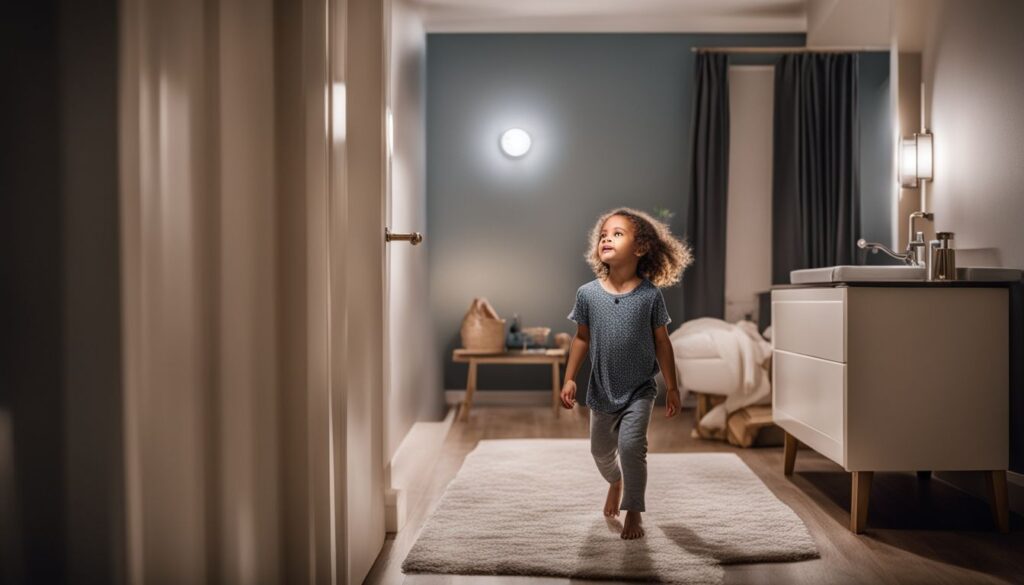Navigating the world of nighttime potty training can feel like a daunting task for many parents. Despite approximately 15% of healthy 5-year-olds still needing overnight protection, it’s possible to achieve nighttime dryness with the right approach and plenty of patience.
This comprehensive guide will provide you with tried-and-tested techniques, expert advice, and real-life tips to make this phase of your child’s development smoother and less stressful.
Ready for some game-changing insights? Let’s dive in!
The Difference Between Daytime and Nighttime Potty Training

Daytime potty training is not the same as nighttime potty training. Kids learn to hold it during their play in the day. It happens while they are awake and aware of what’s happening around them.
How to potty train a girl fast [Guide]
But nighttime potty training needs a fully grown bladder and a mature brain. These help kids wake up when they have to pee at night.
Nighttime potty training can take more time than daytime ones. During the day, kids can go to the toilet or use the potty. When it’s dark, there may only be one chance before morning comes again.
The child’s room should have a well-lit path leading to the toilet so kids don’t stumble on things when they get out of bed at night.
Remember, every child grows at his or her speed. Some might stay dry during naps by age 2, while others might need until age 5 for full overnight dryness.
When to Start Nighttime Potty Training

It’s best to start nighttime potty training when your child is ready. This may be different for every child. Some kids may show signs of readiness by age 2 or 3, while others might not be ready until they age.
Around this time, many children can stay dry during the day and are using the potty often.
You should also note if your kid stays dry at night. If they wake up with a dry pull-up several nights in a row, it could mean that they’re ready for nighttime potty training. Your child’s interest in wearing underwear at night is another sign that you can start the process.
Nighttime potty training goes smoothly for some children but takes longer for others. Don’t rush it! Even though daytime potty habits are easy to track, staying dry overnight might take longer.
It’s okay if your child isn’t fully trained until he or she turns 5.
Signs of Overnight Potty Training Readiness

Your child may be ready for nighttime potty training. The signs can be easy to spot:
- Your child has mastered daytime potty training. They use the bathroom during the day with no issues.
- Your child stays dry at night. This means they are not wetting their bed or diaper while they sleep.
- Your child asks about wearing underwear at night. They want to make the switch.
- A few nights in a row, your child’s diaper is dry in the morning.
- Going potty before bedtime becomes part of your kid’s routine.
- They wake up to use the potty at night and can go back to sleep afterward.
How to Successfully Potty Train at Night

Ensure your child has mastered daytime potty training before transitioning to nighttime. Make your home and bathroom toddler-proof for safety during nighttime bathroom visits.
Maintain a consistent morning and bedtime schedule, encouraging going to the toilet as part of the routine. Always celebrate their small victories in this process to boost their confidence.
Master Daytime Potty Training
Daytime potty training is critical. Start by helping your child get used to the potty. Make it fun and easy for them. After that, getting dry at night will become easier. Soon, you’ll see they can stay dry during the day on their own!
Toddler-Proof Your Home and Bathroom
Making your home and bathroom safe for toddlers is critical to successful potty training. Here are ways to make it easy for your child:
- Put a small potty or toilet seat in the child’s room.
- Make sure there is a clear, well-lit path to the bathroom. This can make a child feel safe and comfortable at night.
- Use disposable sheet protectors on beds and other areas where kids might sit.
- Keep the bathroom clean and free of clutter.
- Install safety locks on cabinets that hold cleaning supplies and medicines.
- Get a step stool so your child can reach the toilet with ease.
- Use special underwear or training pants instead of diapers at night.
- Be prepared for accidents; they will happen.
- Limit drinks before bedtime to ensure a dry night.
Set a Consistent Morning and Nighttime Schedule
Making a morning and night schedule can make nighttime potty training more accessible.
- Start the day by taking your child to the potty as soon as they wake up.
- Be sure to use the toilet or potty right before bed, too.
- Also, have them try potty before they drift off to sleep.
- Keep lights on their way to the bathroom so they feel safe at night.
- Let them stay in their big – kid bed, but keep a potty close for easy access 24/7.
- Wake your child at night and guide them to the bathroom if needed.
- Use an alarm if it helps, but don’t force it if it disturbs your sleep.
- Accidents will happen, but that’s part of the potty training process.
Celebrate Their Successes
Cheer for your child when they do a good job. This can make them want to keep doing well. Give a small gift or sticker if they stay dry at night. A fun dance, high-five, or kind words can also work well.
This is positive reinforcement, and it helps kids learn new skills like potty training faster! Remember, not all children train the same way; some may take longer than others.
But no matter what, let your child know how proud you are of each step forward in this significant change!
Dealing with Bedwetting Issues
Bedwetting issues are common in kids. It is part of the potty training process. Kids often have bedwetting accidents at night while they sleep.
But it’s not their fault. The brain and bladder must grow before kids can stay dry at night.
Being patient is key. You may feel slightly upset when you find wet sheets in the morning, but don’t show this to your kid. Instead, clean up without fussing about it too much. This will help your child not to feel bad or scared if they wet the bed again.
Not all kids are ready for nighttime potty training at age five or six, which is expected. If bedwetting continues after age 7, parents should seek medical advice (essential facts).
Not all kids are ready for nighttime potty training at age five or six, which is expected. If bedwetting continues after age 7, parents should seek medical advice (essential facts).
Also, use things like special underwear and disposable sheet protectors. Limit drinks before bedtime and wake them up once at night to use the toilet as part of a bedtime routine until they learn to do it independently.
Tips from Real-Life Parents
Here are some great tips from real-life parents. These can ease the path to nighttime potty training success.
- Set up a well – lit path to the bathroom. Make it easy for your child to get out of bed and go potty during the night.
- Some parents suggest using disposable sheet protectors. These make changing easier if wet sheets are in the middle of the night.
- Limiting your child’s drink to one hour before bedtime is a good idea. This trick reduces bedwetting cases.
- Always take them to the toilet half an hour before sleep time and once more right before they drift off.
- Repeated practice helps a lot! Kids learn best by doing something over and over again.
- Try ‘dream pee.’ Wake your child up for a quick toilet visit just before you go to sleep yourself, around 11 p.m.
- Stay calm and positive, even when accidents happen. They are part of potty training!
- Use special underwear at night only when your little one stays dry overnight for several nights.
- Another parent’s tip: wait until your child has mastered daytime potty training before starting with nighttime training.
Conclusion
That’s all on nighttime potty training. You can now take steps to help your child get through the night dry and happy. Remember, this is a big step for them too! Potty training at night needs time, so stay patient and make sure it’s fun for your kid.
